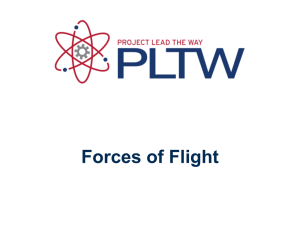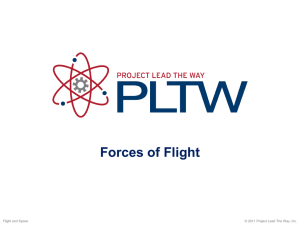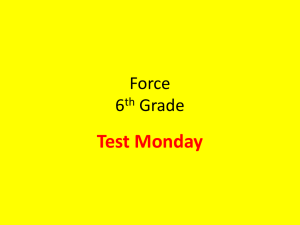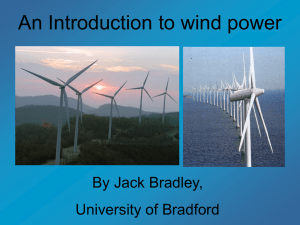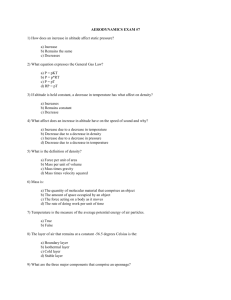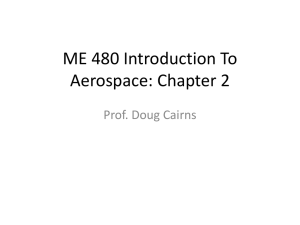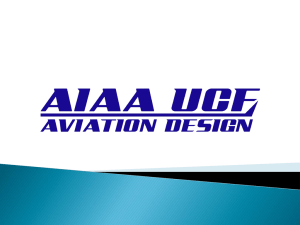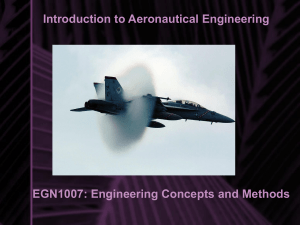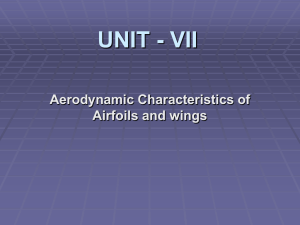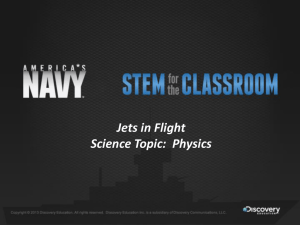Theory of Flight - Four Forces
advertisement
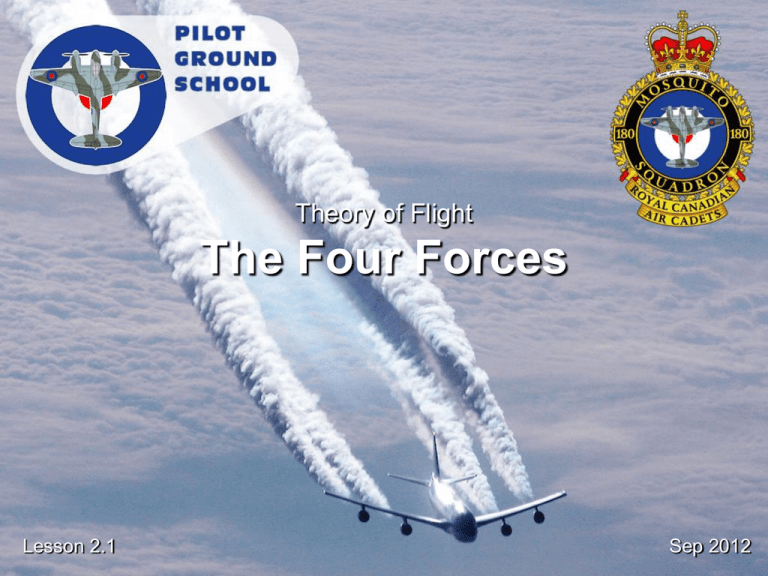
Theory of Flight The Four Forces Lesson 2.1 Sep 2012 Reference From the Ground Up Chapter 2.1.1: Forces Acting on an Airplane in Flight Pages 15 - 20 Introduction • Theory of Flight is a study into the basic physics of why and how aircraft are able to fly, maneuver and keep stable in the air. • Aircraft fly and maneuver in the air by controlling the many forces acting on and created by them. Outline • The Four Forces • Equilibrium • Couples The Four Forces • • • • Lift Weight Thrust Drag Lift • Upward force that keeps aircraft in flight • Created by wing (airfoil) • Directly opposed to weight • Acts perpendicular to the Relative Airflow Airfoil • Definition: Any surface designed to obtain a reaction from the air through which it moves • Camber – Curve of upper and lower surfaces of wing Airfoil • Chord – Imaginary line running from leading edge to trailing edge Airfoil • Boundary Layer – Thin sheet of air that sticks to wing as it moves through air. – When smooth, called Laminar Layer – At Transition Point, it becomes Turbulent Layer Laminar Turbulent Airfoil • Relative Airflow – Direction of air flowing relative to wing (AKA relative wind) – Created by motion of airplane through air (it’s flight path) Relative Airflow Flight Path Airfoil • Lift acts perpendicular to the relative airflow • Angle of Attack – Angle between relative airflow and chord How Lift Is Created • Newton’s Laws of Motion: 1. An object in motion tends to remain in motion (i.e. inertia) 2. An external force must be applied to alter the state of uniform motion of a body 3. For every action, there is an equal and opposite reaction How Lift Is Created • When air hits wing, it’s deflected down (downwash). The opposite reaction is an upward force. Downwash How Lift Is Created • Bernoulli’s Principle: – The total energy in any system remains constant. If one element increases, another must decrease to balance it. How lift Is Created • Airflow over top of wing flows faster, therefore pressure drops • Airflow on bottom of wing flows slower, therefore pressure increases Centre of Pressure • If we consider all distributed pressures to be equivalent to a single force, this force will act through a straight line. • Point where this line cuts the chord is called the Center of Pressure (C of P). • When angle of attack increases: – Lift and drag increase – C of P moves forward – After point of stall (AKA stalling angle), C of P moves back Weight • Downward force due to gravity • Directly opposed to lift • Weight of aircraft acts through Centre of Gravity (C of G) • C of G is point through which resultant of the weights of all various parts of the aircraft pass • Always acts towards centre of the Earth Thrust • Force exerted by engine and it’s propeller or jet • Air pushed backward, causing an equal and opposite reaction, or thrust, in forward direction • Opposed to Drag Drag • Resistance to aircraft when moving forward through air • Opposed to Thrust • Types: – Induced Drag – Parasite Drag • Form Drag • Skin Friction Parasite Drag • Created by all parts of aircraft which do not contribute to lift (e.g. fuselage, wheels, antennas, etc). • Form Drag - Created by form or shape of a body as it resists motion through air • Reduced by streamlining • Skin Friction - Tendency of air flowing over a body to cling to surface. Made worse by dirt, mud, ice etc. Induced Drag • Induced Drag - Caused by parts of aircraft which are active in producing lift (e.g. the wing). • Cannot be eliminated, but can be reduced. • Greater angle of attack = Greater induced drag • Airflow over top of wing flows inward. Airflow under wing flows outwards. Therefore at trailing edge, small eddies are created. These move to tips, resulting in wing tip vortices, which are main component of induced drag. • Ground Effect – Vortices reduced very close to the ground, therefore induced drag is greatly decreased Aileron Drag • When aircraft banks to make a turn, one aileron is down and other is up • Down going aileron = More lift = more drag • Up going aileron = Less lift = Less drag • Result is yaw in opposite direction to which bank is applied • Fixed by using Differential Ailerons, where up going aileron goes up more than the other goes down. Equilibrium • When two forces are equal and opposite, object is in equilibrium • Therefore, when thrust and drag are equal and opposite, aircraft will move forward at a constant speed • Equilibrium refers to steady motion and not state of rest • If either of these forces become greater than force opposing it, equilibrium will be lost Equilibrium • When thrust and drag are equal and opposite, they are in equilibrium. – If thrust is greater than drag, airplane will accelerate. – If drag is greater than thrust, airplane will decelerate. • When lift and weight are equal and opposite, they are in equilibrium. – If lift is greater than weight, airplane will climb. – If weight is greater than lift, airplane will sink. Couples • When two forces (such as lift and weight) are equal and opposite, but parallel rather than passing through the same point, they form a couple. • A couple will cause a turning moment about a given axis (couples act around the C of G). Couples • Weight ahead of Lift – Nose down Couples • Lift ahead of Weight – Nose up Couples • Thrust below Drag – Nose up Couples • Drag below Thrust – Nose down Next Lesson 2.2 - Theory of Flight Wing Design From the Ground Up Chapter 2.1.2: Design of the Wing Pages 20 - 23
